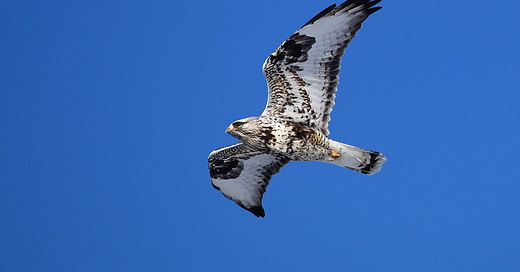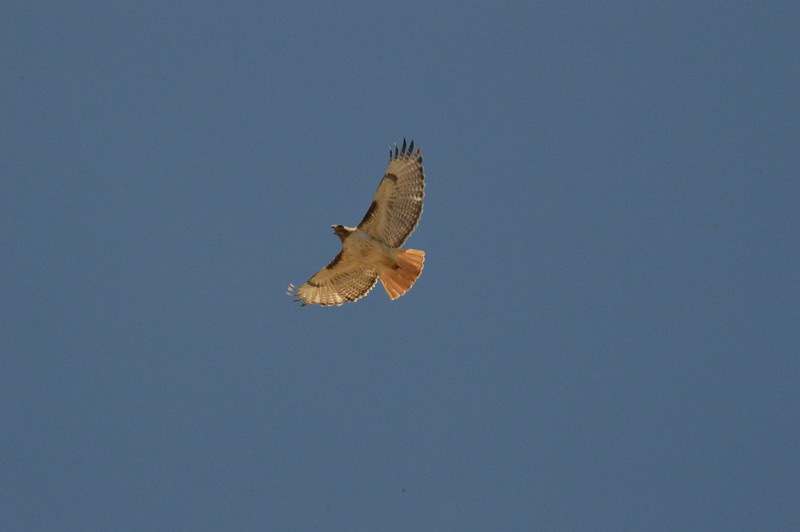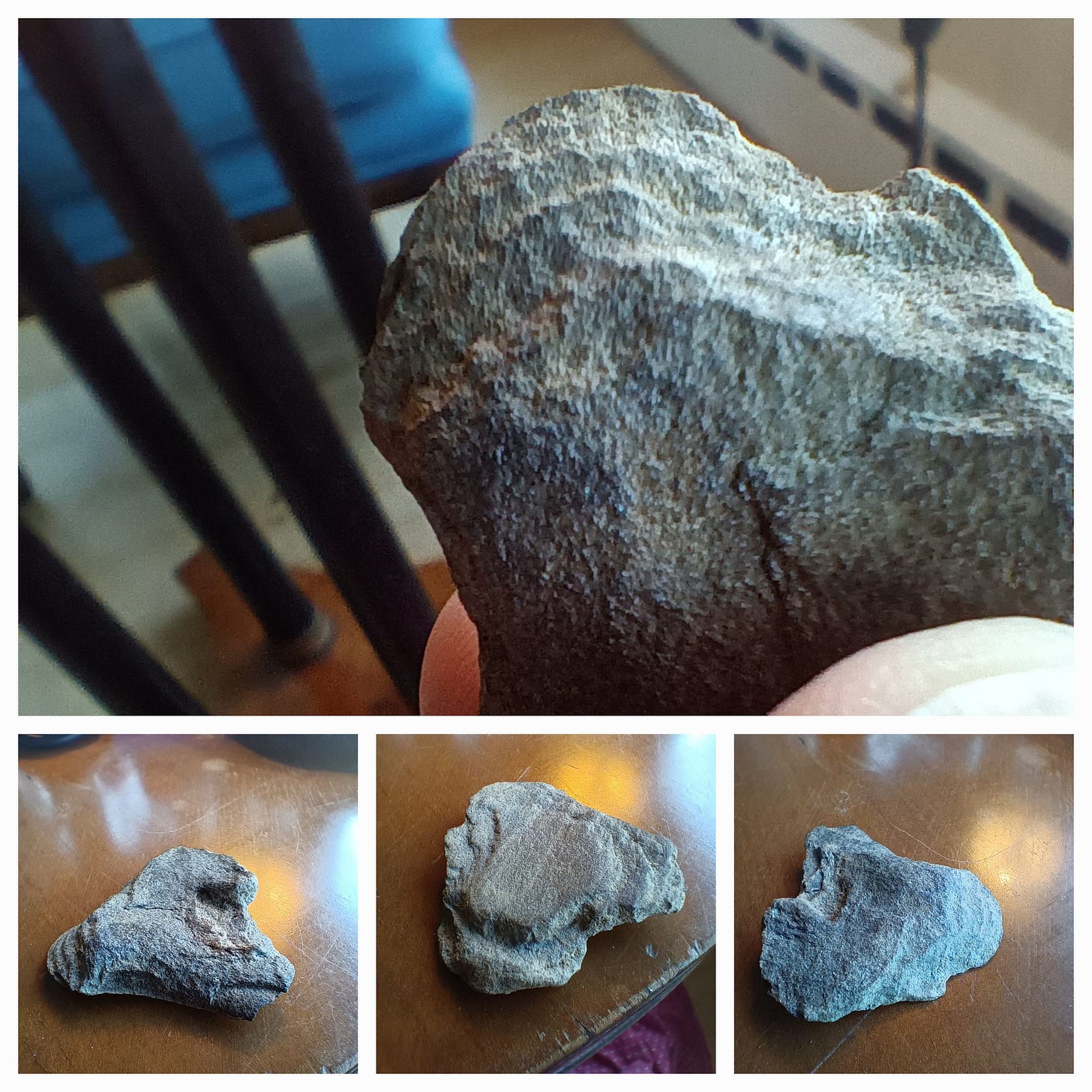Study Up: A Winter Hawk
Keep an eye out for rough-legged hawks among the big hawks you commonly see. While they might have been here already, the next few weeks are when they commonly become more likely. They’re big like red-tailed hawks but they’ll look notably different from below. Here’s a picture of a rough-legged from the US FWS:
And here’s a picture of a red-tailed hawk, also from the US FWS:
Field Mark #1: What does the tail look like? Orangey-red means red-tail. There are other choices for juveniles, so the lack of the reddish tail does not mean rough-legged. That dark band does incline one to think rough-legged.
Field Mark #2: How about the epaulets? The red-tail’s are smaller and the rough-legged’s are more of a dark leading edge.
Also, there’s a behavioral tell: Rough-legged hawks will flap hard to stay in one place. Red-tails soar, for the most part, although I found a video of one leaning into the wind here. You can get into a pretty good argument with some birders about whether what the rough-legged does is hovering or not, depending on the definition of “hover,” but it legit looks like hovering to me, even if a hummingbird might argue the point. I see rough-leggeds just being a more flappy species.
I was brief in setting this out, because my hope is just that you’ll be ready when you see a hawk overhead that’s a little unfamiliar. For a detailed 10+ minute discussion, you can watch this excellent video.
Now is when northern shrikes are likely to start turning up. If you see something that looks like a bulked-up mockingbird, it may be a shrike. They have superficially similar behaviors in some ways. Shrikes are inclined toward open places such as airports and meadows. They tend to select vantage points that give them a wide view of the area they’re stopped in. Here’s some official differences to watch for from AllAboutBirds.
Overflight: In Which I May Have Found a Stone Age Chopper
Birding in winter tends toward a Zen experience. I don’t have feeders yet, but I’m thinking of putting some up. Without much snow, we only see flocks of sparrows and juncos occasionally in the yard here in Holyoke’s Oakdale.
I do recommend that you not isolate your experience only to birding. If you can walk when you bird, enjoy the parts of being outdoors that birds got you out to enjoy.
I passed an uprooted tree last week and stopped to check for stone artifacts in the dirt its roots still clutch. I have read a few places that such roots are a good place to look, because the dirt is closer to eye level and it hasn’t been exposed for generations. I’ve stopped here many times, usually while mini-flocks of titmouses and chickadees swirl nearby. This time, I found a stone that looks like it was shaped into a small chopper, with a tang to bind it to a stick. I might be wrong — the material is a soft stone that might not have lasted long under the punishment of repetitive smacking, so there’s reason to believe that my pareidolia (the inclination to find patterns where there aren’t any) is betraying me (again).
Birding is a transporting hobby. It’s also a keyhole view into the world outside our dwellings and workplaces (which have been the same for me since 1995, when I got my first work-at-home job) that gives us reasons to be in different thinking spaces. For a few minutes or hours we can be creatures of sense as well as analysis.
Finding this makes me think of the world when the object was last touched by human fingers. If it is something truly that old, it could be anywhere from early human settlement of the Americas to contemporaneous with European presence, as far as I know. But it likely dates from a some time when the Holyoke hillside where I collected it was open land, kept burned back by people who managed the landscape for hunting and gathering (and maybe some agriculture).
What would birds have been then? Without the easy ability to see them with optics, they may have been more mysterious in their species. Or, perhaps, with the ability to snare them and the perfect abundance that would have allowed that to be easy and not morally troublesome, maybe they would have been as nameable as the constellations. But maybe the people who experienced them didn’t need to categorize the birds that didn’t need categories. Maybe they would have simply been the birds that are eaten and not, used to connect to the weather and not, beheld as objects of exceptional beauty or heard as points that song burst forth from the air.
Zoom: The Freeze
Ice is starting to matter. Many waterfowl avoid ice pretty fiercely and many sea ducks won’t stand on it if they can avoid it. Also, many sea ducks cannot take flight without a decent stretch of open water — loons (which are not ducks) need 100 feet or more. Puddle ducks of many kinds can take off from a standing start like a helicopter, so they’re not afraid to stand on the ice, but they’re not inclined to if there’s nothing to hope for from doing so.
A topic we’ll come back to over and over is finding places with an abundance of some scarce quality. In this case, it’s ice-free water. Big stretches of water don’t have ice where the water in the middle is still thawed, usually thanks to motion and maybe an upwelling of warm water from below. Also, where surface water pours in, sometimes there’s less ice. And there are places where human activity like a power plant outflow leads to less ice. There are more reasons, but start with these.
Especially the warm water from a surface or human activity is helpful here, because it’s usually easy for humans to get to that part of the open water. That means ducks, geese, and even the birds of prey that eat them. You can find a peregrine or an eagle sometimes where there’s open water. An example is the pond at Umass-Amherst, where one year at the Christmas Bird Count, I saw about 1,000 mallards (and a green-winged teal). That many birds can even lead to the self-confirming process of bird movement keeping the water moving enough to keep it clear of ice.
Birdscape: A Holyoke Riverside Farm
Last weekend I parked and walked at Land of Providence in Holyoke. The river is unfrozen but it’s flowing fast, so I didn’t have any birds on it, but I did get a chance to see a flock of crows (I don’t say murder because reasons) chatting and then moving across the water. Onshore, there’s a good dirt road that circles the fields where Nuestras Raices runs an urban farm. The sparrows and other winter mini-flocks were thick on the ground, right near the path, and easy to see. I also had a hermit thrush, which is always a benediction this time of year. When you see these small but predictable anomalies like the hermit thrush and the bluebird, it’s a reminder that life bets on extremity. Somewhere that bird’s mother and father wish it would not take so many risks and want it to go somewhere warmer and safer. Not that I have issues as a single parent.
Bird Books and Whistles: Vulture
I’m reading (well, listening to) A House With Good Bones, a horror novel by T Kingfisher. I can speak very well of her protagonist, who characterizes herself as an entomologist but does a fine job in the first pages of noting the differences between black and turkey vultures. This is not a bird book. But is a book with birds.
Flyaway
Next issues: I have previously promised a look at Flight Calls. It would be a mistake to renew my promise of “one more issue,” but I will get to a thorough review of this excellent work.
In late December, we can look forward to a surge in waterfowl sightings as conditions offer our largest bodies of water the power to concentrate birds who have been pushed south due to ice. And we’ll take a longer look at short-eared owls and where to see them in Western Massachusetts.






